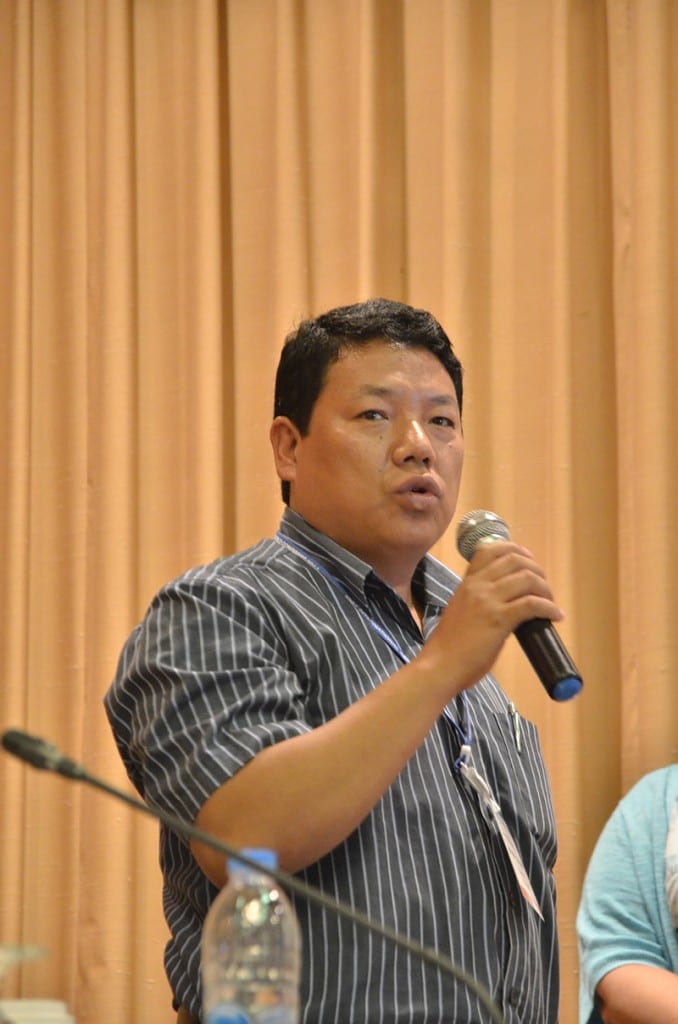In October 2014, we held the 68th World Congress of IOGT International in Cha Am, Thailand and I had the honor and privilege to be part of the organising team.
At the World Congress, we had a number of special guests and among them was Mr. Tandin Chogyel, National Counterpart, Sr. Program Officer, at the Mental Health and Substance Abuse Program, of the Department of Public Health at the Ministry of Health.
- World Congress participant
- During a workshop, taking the floor
Recently Tandin wrote to us saying:
Now Bhutan Government has approved the National Policy and Strategic Framework to Reduce Harmful use of Alcohol. This is my biggest achievement as I have been working on this since 2011.”
The Royal Government of Bhutan had paved the way already in 2010, when the need to address alcohol harm through alcohol policy featured in the Ministry of Education’s National Youth Policy.
Alcohol liver disease (ADL) is the number one cause of death in Bhutan, with one death in every two days being linked to ADL. The problem has reached epidemic proportions: in 2005 there were 1217 ALD cases but in 2014, the government recorded more than 3000 cases, the numbers of ALD associated deaths have also been increasing since 2005.
That’s the background for Tandin’s statement.
On December 2, 2015, the government approved the National Policy and Strategic Framework To Reduce Harmful Use of Alcohol (2015-2020). As you can imagine from Tandin’s statement, the process had been long and difficult. It started more than four years ago, in June 2011.
Alcohol harm in Bhutan
Per capita adult consumption of pure alcohol is 8.47 litres, which is higher than the average global consumption of 6.2 liters. There are 5,407 alcohol outlets in the country today or one outlet per 98 Bhutanese (aged 15 and above). And as unlicensed outlets are believed to be ubiquitous, the outlet density is considerably higher with illegal outlets included in the figures. There pervasiveness of alcohol use in Bhutan causes tremendous alcohol harm:
- The annual costs for hospital treatment of alcoholism alone, which represents a fraction of the total burden, was estimated at BTN 29 to 30 million (ca. half a million USD) from 2005 to 2009.
- Alcohol revenue does not compensate for the economic costs incurred as a result of alcohol harm, such as loss of productivity, and premature deaths.
- About 7% of road accidents are attributed to drink under the influence of alcohol.
- Police reports also show an increase of domestic violence cases related to alcohol. 70% of cases of domestic violence were committed by perpetrators under the influence of alcohol. Alcohol is also reported as a contributory factor to homicides.
- Alcohol can also aggravate the HIV/AIDS epidemic which is a serious obstacle to Bhutan’s development as more than 60% of the country’s population is less than 25 years of age.
- Alcohol and poverty form a vicious cycle.

Inspiration from the World Congress
We were honoured and delighted to host Tandin in Cha Am and to discuss with him a number of the issues above. In a special session on alcohol and women, we explored how alcohol policy could help to reduce and prevent gender-based violence. In a high-level panel on alcohol as an obstacle to development, we explored ways to address alcohol harm and prevent alcohol induced poverty.
We were able to bring Tandin together with world class scientists, like Dr. Thaksaphon Thamarangsi, Prof. David Jernigan, or Prof. Monica H. Swahn and in this way provide expert insights on issues such as “alcohol use, GBV, and HIV/ Aids“, “alcohol industry strategies, especially marketing” and “building alliances for alcohol policy movements“.
Bhutan’s comprehensive response to alcohol burden
I congratulate Tandin on his work and I congratulate the Health Ministry and whole government for their commitment and effort to see this through.
We are glad and proud to see this comprehensive policy now. It addresses the three best buys for preventing and reducing alcohol harm: decreasing alcohol availability, affordability and regulating marketing.
Long before our 68th World Congress did we work with the government of Bhutan and advised them on the alcohol policy development. But of course, credit belongs to many more influential and decisive people and actors, from the region and from around the world, that provide support, expert advise, inspiration and encouragement. We are happy to have been one among them all.
—
Background reading:
Kuensel Online: “Cabinet endorses strong alcohol policy“
Kuensel Online: “Breaking bottlenecks that could strangle new alcohol policy“
Royal Government of Bhutan: “The National Policy and Strategic Framework to Reduce Harmful Use of Alcohol (2013-2018)”
Alcohol Policy in Bhutan: Recommendations for the National Strategic Framework for Reducing Harmful Use of Alcohol in Bhutan. Report to Ministry of Health, Royal Government of Bhutan WHO Regional Office for South-East Asia, By Thamarangsi, Junsirimongkol, Waleewong, Tessuwan
Kuensel Online: “ALD the top killer disease still“
Royal Government of Bhutan: “Ministry of Education’s National Youth Policy“


